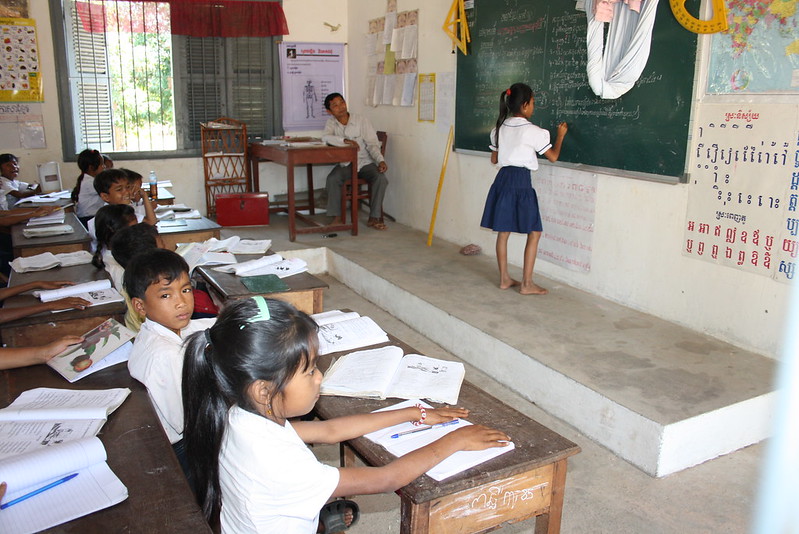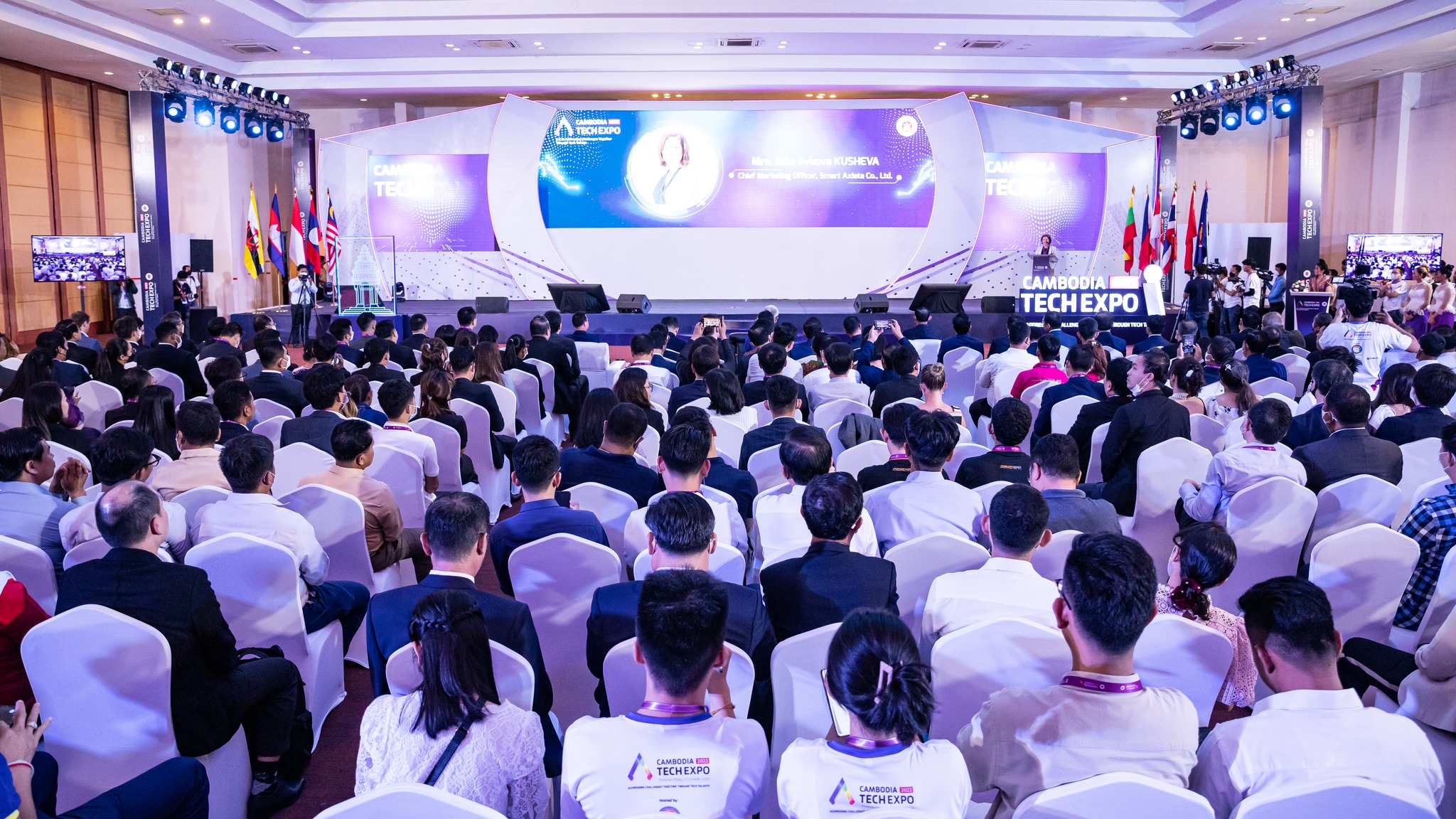រាជរដ្ឋាភិបាលកម្ពុជាបានបន្តខិតខំកែទម្រង់វិស័យអប់រំគ្រប់កម្រិត។ ប៉ុន្មានឆ្នាំមកនេះ គោលនយោបាយ និងបទប្បញ្ញត្តិត្រូវបានអនុវត្តដើម្បីបង្កើនគុណភាពអប់រំ ភាពងាយស្រួល ប្រសិទ្ធភាព បរិយាប័ន្ន និងតម្លាភាព។ គោលនយោបាយ និងបទប្បញ្ញត្តិទាំងនោះរួមមាន ផែនការយុទ្ធសាស្ត្រអប់រំ ២០១៩-២០២៣, ផែនទីបង្ហាញផ្លូវការអប់រំមធ្យមសិក្សាកម្ពុជាឆ្នាំ ២០៣០, គោលនយោបាយ ស្ដីពី ចក្ខុវិស័យឧត្តមសិក្សា ២០៣០, ផែនទីបង្ហាញផ្លូវ ការអប់រំកម្ពុជាឆ្នាំ២០៣០ (គោលដៅអភិវឌ្ឍន៍ប្រកបដោយចីរភាពទី៤), គោលនយោបាយ ស្តីពី សាលារៀនជំនាន់ថ្មី, គោលនយោបាយ ស្តីពី ការអប់រំប្រកបដោយបរិយាប័ន្ន និងគោលនយោបាយជាតិ ស្តីពី ការសិក្សាពេញមួយជីវិត។ ការអភិវឌ្ឍធនធានមនុស្សមានសារៈសំខាន់ណាស់ក្នុងការសម្រេចបាននូវគោលដៅសេដ្ឋកិច្ចឆ្នាំ ២០៣០ ដើម្បីក្លាយជាប្រទេសដែលមានចំណូលមធ្យមកម្រិតទាប។ រដ្ឋាភិបាលបានយកចិត្តទុកដាក់លើការអប់រំ និងការបណ្តុះបណ្តាលដើម្បីបង្កើនធនធានមនុស្ស។ ការប្តេជ្ញាចិត្តរបស់រដ្ឋាភិបាលអាចមើលឃើញនៅក្នុងការចំណាយលើការអប់រំប្រចាំឆ្នាំ។ នៅឆ្នាំ ២០២១ ការចំណាយលើវិស័យអប់រំមានចំនួន ៨១០ លានដុល្លារអាមេរិក និង ៧៩៧ លានដុល្លារសម្រាប់ឆ្នាំ ២០២២។1
លទ្ធភាពទទួលបានការអប់រំ
យោងតាមមាត្រា ៦៨ នៃរដ្ឋធម្មនុញ្ញ រដ្ឋាភិបាលមានកាតព្វកិច្ចផ្តល់ការអប់រំជាមូលដ្ឋានរយៈពេលប្រាំបួនឆ្នាំដោយឥតគិតថ្លៃសម្រាប់ប្រជាពលរដ្ឋកម្ពុជាដែលមានសិទ្ធិទទួលបាន។ ក្រសួងអប់រំ យុវជន និងកីឡា បានជំរុញ និងលើកកម្ពស់ការចុះឈ្មោះចូលរៀនថ្នាក់មូលដ្ឋាននៅទូទាំងប្រទេស ជាពិសេសសម្រាប់ក្រុមជនងាយរងគ្រោះ និងអ្នករស់នៅជនបទ និងដាច់ស្រយាល។2 យោងតាមស្ថិតិអប់រំសាធារណៈឆ្នាំ ២០២០-២០២១ អត្រាចុះឈ្មោះចូលរៀននៅកម្រិតបឋមសិក្សាមាន ៨៦.៨ ភាគរយសម្រាប់ឆ្នាំសិក្សា ២០២១-២០២២។ នៅតំបន់ជនបទមានកុមារចំនួន ១.៦៦៤.៩២៥ នាក់បានចុះឈ្មោះចូលរៀននៅសាលាបឋមសិក្សាសាធារណៈ ខណៈដែលនៅតាមទីក្រុងមានកុមារចំនួន ៣៤៥.៣៦១ នាក់បានចូលរៀនដូចគ្នា។3
រដ្ឋាភិបាលបានដាក់ចេញនូវគោលនយោបាយស្តីពីការអប់រំប្រកបដោយបរិយាប័ន្ន ដើម្បីគាំទ្រ និងដោះស្រាយបញ្ហាលទ្ធភាពទទួលបានការអប់រំរបស់សិស្ស ដោយផ្តោតជាពិសេសលើកុមារដែលមានតម្រូវការពិសេស និងក្រុមដែលខ្វះខាត។4 គោលនយោបាយនេះក៏ផ្តោតលើហេដ្ឋារចនាសម្ព័ន្ធនៃសាលារៀន និងអនាម័យផងដែរ ដោយធ្វើឱ្យមានបរិយាកាសប្រកបដោយសុវត្ថិភាព និងផាសុកភាពសម្រាប់សិស្សដែលមានតម្រូវការពិសេស។5
ក្នុងផែនការយុទ្ធសាស្ត្រអប់រំ ២០១៩-២០២៣ ការកែលម្អលទ្ធភាពទទួលបានការអប់រំ គឺជាគោលនយោបាយចម្បងមួយសម្រាប់ការអប់រំបឋមសិក្សា និងមធ្យមសិក្សា។6 ដោយអនុវត្តតាមគោលការណ៍នៃការអប់រំប្រកបដោយបរិយាប័ន្ន និងការអប់រំសម្រាប់ទាំងអស់គ្នា ក្រសួងអប់រំ យុវជន និងកីឡាបានសង្កត់ធ្ងន់យ៉ាងខ្លាំងដល់ក្រុមងាយរងគ្រោះ ដូចជាកុមារមានពិការភាព និង ជនជាតិដើមភាគតិច ដើម្បីធានាបាននូវសមភាពក្នុងការចូលរៀននៅសាលាបឋមសិក្សា។ ផែនការយុទ្ធសាស្ត្រអប់រំ បានដាក់ចេញនូវយុទ្ធសាស្ត្រចំនួនបីសម្រាប់កម្រិតបឋមសិក្សា ដើម្បីធានាឱ្យសិស្សទទួលបានការអប់រំដូចជា៖
- ពង្រីកវិធានការនានាដើម្បីបង្កើនការចូលរៀន វត្តមានទៀងទាត់ និងរៀនចប់បឋមសិក្សាជាពិសេសក្រុមកុមារជួបការលំបាក
- អភិវឌ្ឈហេដ្ឋារចនាសម្ព័ន្ធរូបវ័ន្ត និងបរិស្ថានសិក្សាស្អាត និងមានសុវត្តិភាពស្របតាមស្តង់ដាសាលារៀនបឋមសិក្សា ជាពិសេសសាលារៀនមិនគ្រប់កម្រិត និងសាលារៀនជួបការលំបាក
- លើកកម្ពស់សុខភាពរបស់កុមារនៅតាមសាលារៀនបឋមសិក្សា
លើសពីនេះ គោលបំណងមួយនៃផែនទីបង្ហាញផ្លូវការអប់រំមធ្យមសិក្សាកម្ពុជាឆ្នាំ ២០៣០ គឺការមិនរើសអើង ដោយធានានូវឱកាសស្មើៗគ្នាសម្រាប់ប្រជាជនកម្ពុជាទាំងអស់ក្នុងការទទួលបានការអប់រំមធ្យមសិក្សាដោយមិនគិតពីភេទ ស្ថានភាពសង្គម ភូមិសាស្ត្រ ភាសា សាសនា និងជនជាតិ។7 វាបានកំណត់នូវផែនការមួយ ដើម្បីបង្កើនលទ្ធភាពទទួលបានការអប់រំមធ្យមសិក្សា ដែលជាកម្រិតអប់រំដែលមានសារៈសំខាន់សម្រាប់ការអភិវឌ្ឍបុគ្គល។8
ក្នុងឆ្នាំ ២០១៩ ក្រសួងអប់រំ យុវជន និងកីឡាបានអនុវត្តគោលនយោបាយជាតិស្តីពីការសិក្សាពេញមួយជីវិត ដោយមានការគាំទ្រពីដៃគូអភិវឌ្ឍន៍គឺអង្គការយូណេស្កូ។9 មិនត្រឹមតែផ្តោតទៅលើការអប់រំផ្លូវការប៉ុណ្ណោះទេ ប៉ុន្តែគោលគំនិតនៃការសិក្សាពេញមួយជីវិតក៏យកចិត្តទុកដាក់យ៉ាងខ្លាំងចំពោះការអប់រំវិជ្ជាជីវៈដែលអាចស្ថិតក្នុងទម្រង់នៃការអប់រំក្រៅផ្លូវការ និងក្រៅប្រព័ន្ធផងដែរ។10 គោលនយោបាយនេះធានាថា ប្រជាជនកម្ពុជាទាំងអស់អាចទទួលបានការសិក្សាជំនាញ និងឱកាសដែលមានប្រយោជន៍សម្រាប់ការអប់រំនៅគ្រប់វ័យ ដើម្បីទ្រទ្រង់ការរស់នៅរបស់ពួកគេ ជាពិសេសការបោះបង់ការសិក្សា ជនជាតិភាគតិច ពលករចំណាកស្រុក អ្នកអត់ការងារធ្វើ និងក្រុមជនក្រីក្រ។ អង្គការយូណេស្កូបានបញ្ជាក់ថា ការរៀនសូត្រពេញមួយជីវិត គឺជាដំណើរការមួយដែលជំនាញ និងចំណេះដឹងត្រូវបានលើកកម្ពស់ ដើម្បីបង្កើនសន្តិភាព និងភាពសុខដុមរមនាក្នុងសង្គម។11
គុណភាពនៃការអប់រំ

សិស្សកំពុងឈរធ្វើលំហាត់នៅក្នុងថ្នាក់។ រូបភាពដោយ Global Partnership for Education ថតនៅក្នងខែធ្នូ ឆ្នាំ២០១១។ ក្រោមអាជ្ញាប័ណ្ណ CC BY-ND 2.0។
រដ្ឋាភិបាលមានគោលដៅប្រែក្លាយប្រទេសកម្ពុជាទៅជាសង្គមដែលផ្អែកលើចំណេះដឹង ដូច្នេះការកែលម្អគុណភាពអប់រំ គឺចាំបាច់ដើម្បីសម្រេចគោលដៅនេះ។ គុណភាពអប់រំគឺជាកត្តាសំខាន់ក្នុងការធានាថាសិស្សានុសិស្សត្រូវបានបំពាក់ដោយចំណេះដឹង និងជំនាញអនុវត្តជាក់ស្តែងដែលអាចប្រកួតប្រជែងជាមួយនឹងស្តង់ដារតំបន់ និងអន្តរជាតិ។ ប៉ុន្មានឆ្នាំមកនេះ ក្រសួងអប់រំ យុវជន និងកីឡា បានដាក់ចេញនូវកំណែទម្រង់ និងវិធីសាស្ត្រជាច្រើន ដោយផ្តោតលើវិស័យផ្សេងៗគ្នា ដូចជាគុណភាពនៃការបង្រៀន និងការសិក្សា ហេដ្ឋារចនាសម្ព័ន្ធ និងការគ្រប់គ្រង។12ឧទាហរណ៍ដូចជា ការដំឡើងប្រាក់បៀវត្សរ៍របស់គ្រូ និងកំណែទម្រង់ការប្រឡងចេញថ្នាក់ទី១២ គឺជាវិធានការដែលព្យាយាមលើកកំពស់គុណភាពអប់រំ។13 14 រដ្ឋាភិបាលក៏បានធ្វើការសហការជាមួយដៃគូអភិវឌ្ឍន៍ និងអង្គការឯកជន ដើម្បីជំរុញឱ្យមានកំណែទម្រង់កាន់តែមានប្រសិទ្ធភាព។
ដូចមានចែងក្នុងផែនការយុទ្ធសាស្ត្រអប់រំឆ្នាំ ២០១៩-២០២៣ ក្រសួងអប់រំបានប្តេជ្ញាចិត្តចំពោះក្របខណ្ឌសសរស្តម្ភទាំង ៥ ដែលផ្តល់អាទិភាពដល់គោលដៅកំណែទម្រង់គោលនយោបាយជាតិអប់រំ។15 សសរស្តម្ភមានគោលបំណងលើកកំពស់គុណភាពអប់រំដែលផ្តោតលើគ្រូបង្រៀន និងគុណភាពបង្រៀនរបស់ពួកគេដូចជា៖
- ការអនុវត្តផែនការសកម្មភាពគោលនយោបាយគ្រូបង្រៀន
- ពិនិត្យកម្មវិធីសិក្សា និងសៀវភៅសិក្សា និងកែលម្អបរិយាកាសសិក្សា
- ការអនុវត្តការត្រួតពិនិត្យ
- កែលម្អការវាយតម្លៃការសិក្សា ដើម្បីឆ្លើយតបនឹងកម្រិតជាតិ តំបន់ និងអន្តរជាតិ
- កំណែទម្រង់ឧត្តមសិក្សា។
រដ្ឋាភិបាលបានដោះស្រាយការផ្លាស់ប្តូររចនាសម្ព័ន្ធអប់រំដោយដាក់ឱ្យប្រើប្រាស់ប្រព័ន្ធគ្រប់គ្រងតាមសាលារៀន (SBM)។ វិធីសាស្ត្រនេះបានធ្វើវិមជ្ឈការអំណាចនៃការសម្រេចចិត្តពីកម្រិតកំពូល ដោយអនុញ្ញាតឱ្យសាលារៀនមានការសម្រេចចិត្តគ្រប់គ្រងផ្ទាល់ខ្លួន។16 វាអនុញ្ញាតឱ្យមានការសម្រេចចិត្តអភិបាលកិច្ចស្វយ័ត ដែលអាចផ្តល់អត្ថប្រយោជន៍ និងលើកកម្ពស់គុណភាពនៃការបង្រៀន និងការសិក្សា។ លើសពីនេះ ការគ្រប់គ្រងតាមសាលារៀនក៏នឹងលើកកម្ពស់គណនេយ្យភាពហិរញ្ញវត្ថុ និងការគ្រប់គ្រងហិរញ្ញវត្ថុឱ្យកាន់តែប្រសើរឡើង ដើម្បីឱ្យការបែងចែកមូលនិធិអាចទៅដល់កន្លែងដែលវាត្រូវការ។17 ក្រសួងអប់រំបានអនុវត្ត ការគ្រប់គ្រងតាមសាលារៀនជាគម្រោងសាកល្បងលើសាលារៀនគោលដៅចំនួន ១០០ និងសាលារៀនមិនមែនគោលដៅចំនួន ៣០០ ក្រោមគម្រោងកែលម្អការអប់រំមធ្យមសិក្សាឆ្នាំ២០១៨-២០២២ ។18
បើនិយាយពីផ្នែកផ្គត់ផ្គង់វិញ ក្រសួងអប់រំមានគោលបំណងបំពេញតាមសមាមាត្រគ្រូបង្រៀន និងសិស្ស ៤០:១ ដែលត្រូវបានណែនាំដោយអង្គការយូណេស្កូ។19 នៅឆ្នាំ ២០២១ សមាមាត្រគ្រូបង្រៀននិងសិស្សគឺ ៤៦.២:១ ដែលតម្រូវឱ្យក្រសួងអប់រំជ្រើសរើសគ្រូបង្រៀនចំនួន ៦,៩៥០ នាក់បន្ថែមទៀតសម្រាប់ឆ្នាំសិក្សានោះ។20 បន្ថែមពីលើការជ្រើសរើសថ្មី ក្រសួងអប់រំ យុវជន និងកីឡា ផ្តោតលើការអភិវឌ្ឍសមត្ថភាពគ្រូបង្រៀន ដែលអាចលើកកម្ពស់គុណភាពអប់រំប្រកបដោយប្រសិទ្ធភាព។ ស្ដង់ដារគ្រូបង្រៀនត្រូវមានភាពស្មើគ្នាជាមួយនឹងស្តង់ដារអន្តរជាតិ ដើម្បីធានាថាសិស្សរបស់កម្ពុជាត្រូវបានបំពាក់ដោយជំនាញសតវត្សទី២១។21ដោយសហការជាមួយដៃគូអភិវឌ្ឍន៍ ក្រសួងអប់រំ យុវជន និងកីឡា បានដាក់ចេញនូវគំនិតផ្តួចផ្តើមផ្សេងៗ ដើម្បីបង្កើនការត្រៀមខ្លួនរបស់គ្រូបង្រៀន ក្នុងការបង្រៀនកម្មវិធី និងកម្មវិធីសិក្សាដែលទាក់ទងនឹងឌីជីថល និងទំនើប។22ជាផ្នែកមួយនៃកំណែទម្រង់គ្រូបង្រៀន ការដំឡើងប្រាក់បៀវត្សរ៍គ្រូបង្រៀនគឺជាកំណែទម្រង់យុទ្ធសាស្ត្រមួយ។ ជាឧទាហរណ៍ ៨០ ភាគរយនៃការចំណាយរបស់រដ្ឋាភិបាលឆ្នាំ ២០១៩ សម្រាប់វិស័យអប់រំត្រូវបានបែងចែកដើម្បីលើកកំពស់ប្រាក់ខែគ្រូបង្រៀន។23
វិទ្យាសាស្ត្រ បច្ចេកវិទ្យា និងការអប់រំបែបឌីជីថល
វិទ្យាសាស្ត្រ បច្ចេកវិទ្យា និងជំនាញឌីជីថលបានក្លាយជាកម្លាំងមូលដ្ឋានសម្រាប់ការអភិវឌ្ឍសង្គម និងសេដ្ឋកិច្ចក្នុងយុគសម័យឌីជីថល។24 ការធ្វើឱ្យប្រសើរឡើងនូវបច្ចេកវិទ្យា និងការអប់រំឌីជីថលនឹងរួមចំណែកដល់ដំណើរការនៃការសម្រេចបាននូវគោលដៅសេដ្ឋកិច្ចជាតិទាំងមូល។ លើសពីនេះទៀត រដ្ឋាភិបាលកម្ពុជាក៏បានប្តេជ្ញាផ្លាស់ប្តូរទៅជារដ្ឋាភិបាលឌីជីថល សេដ្ឋកិច្ច និងសង្គម ដូច្នេះការអភិវឌ្ឍបច្ចេកវិទ្យា និងវិទ្យាសាស្ត្រមានសារៈសំខាន់ណាស់។ ចាប់តាំងពីឆ្នាំ ២០០៤ មក រដ្ឋាភិបាលបានចាក់បញ្ចូលការអប់រំផ្នែកវិទ្យាសាស្ត្រ បច្ចេកវិទ្យា គណិតវិទ្យា និងវិស្វកម្ម (STEM) និងបច្ចេកវិទ្យាព័ត៌មាន និងសារគមនាគមន៍ (ICT) ទាំងកម្រិតបឋមសិក្សា និងខ្ពស់ជាងនេះ តាមរយៈកម្មវិធី និងគោលនយោបាយផ្សេងៗ។
គោលនយោបាយអប់រំចុងក្រោយបង្អស់ដែលទាក់ទងនឹង ICT គឺគោលការណ៍ណែនាំគោលនយោបាយសម្រាប់សាលាជំនាន់ថ្មី (NGS)។ គំនិតផ្តួចផ្តើមនេះត្រូវបានអនុវត្តជាលើកដំបូងនៅក្នុងឆ្នាំ ២០១១ ដោយអង្គការសកម្មភាពសម្រាប់ការអប់រំនៅកម្ពុជា (KAPE) ដែលជាអង្គការមិនមែនរដ្ឋាភិបាលដែលធ្វើការក្នុងវិស័យអប់រំ។25 បន្ទាប់មក គម្រោងនេះត្រូវបានសាកល្បងដោយក្រសួងអប់រំ នៅក្នុងឆ្នាំ ២០១៤។ គំនិតផ្តួចផ្តើមនេះបានដំណើរការនៅក្នុងសាលារៀនចំនួន ១០ ក្នុងឆ្នាំ ២០១៥ ហើយមានគោលបំណងឈានដល់ ១០០ សាលារៀននៅឆ្នាំ ២០២២។26 គោលបំណងសំខាន់នៃគំនិតផ្តួចផ្តើមសាលារៀនជំនាន់ថ្មី គឺដើម្បីណែនាំវិធីសាស្ត្របង្រៀន និងរៀនតាមបែបទំនើប និងច្នៃប្រឌិតនៅក្នុងសាលារដ្ឋកម្ពុជា ដូចជាការអនុវត្តការរៀនតាមគម្រោង និងវិធីសាស្ត្រផ្តោតលើសិស្ស។27 គម្រោងសាលាជំនាន់ថ្មី ក៏អនុវត្តប្រព័ន្ធគ្រប់គ្រងតាមសាលាផងដែរ។28

អ្នកចូលរួមក្នុងព្រឹត្តិការណ៍ពិព័រណ៍បច្ចេកវិទ្យាកម្ពុជា។ រូបភាពយកចេញពីទំព័រ Facebook ផ្លូវការរបស់់ពិព័រណ៍បច្ចេកវិទ្យាកម្ពុជា នៅថ្ងៃទី១២ ខែវិច្ឆិកា ឆ្នាំ២០២២។
សម្រាប់ថ្នាក់ឧត្តមសិក្សា និស្សិតបញ្ចប់ការសិក្សាផ្នែកវិទ្យាសាស្ត្រ និងបច្ចេកវិទ្យាមានសារៈសំខាន់ណាស់សម្រាប់ការរីកចម្រើនរបស់ប្រទេស។ ស្របតាមគោលបំណងនៃរបៀបវារៈរបស់រដ្ឋាភិបាលដើម្បីសម្រេចបាននូវរដ្ឋាភិបាល សេដ្ឋកិច្ច និងសង្គមឌីជីថល ការបង្កើនការចុះឈ្មោះចូលរៀន និងនិស្សិតបញ្ចប់ការសិក្សាមុខវិជ្ជាទាក់ទងនឹង STEM គឺជាវិធីសាស្ត្រចាំបាច់មួយ។ នៅក្នុងផែនទីបង្ហាញផ្លូវ វិទ្យាសាស្ត្រ បច្ចេកវិទ្យា និងនវានុវត្តន៍កម្ពុជា ឆ្នាំ ២០៣០ ការកសាងធនធានមនុស្សក្នុងវិស័យវិទ្យាសាស្ត្រ និងបច្ចេកវិទ្យាគឺជាគោលដៅអាទិភាពមួយ។ គោលនយោបាយនេះ រំពឹងថានៅឆ្នាំ២០៣០ ៥០% នៃនិស្សិតសាកលវិទ្យាល័យកម្ពុជានឹងសិក្សាលើមុខជំនាញ STEM ហើយ ៤០% ជាស្ត្រី។29រដ្ឋាភិបាលបានបង្កើតបណ្ឌិត្យសភាបច្ចេកវិទ្យាឌីជីថលកម្ពុជា (CADT) ដែលមានគោលបំណងផ្តល់ការអប់រំ ការបណ្តុះបណ្តាល ការស្រាវជ្រាវ និងការអភិវឌ្ឍ និងលើកកម្ពស់ការច្នៃប្រឌិតផ្នែកបច្ចេកវិទ្យាឌីជីថលដល់សិស្ស និស្សិត មន្ត្រីរាជការ និងអ្នកច្នៃប្រឌិត ដើម្បីចូលរួមចំណែកក្នុងការអភិវឌ្ឍរដ្ឋាភិបាលឌីជីថល សេដ្ឋកិច្ច និងសង្គម។30ស្ថាប័នអប់រំដែលផ្តោតលើឌីជីថល និងបច្ចេកវិទ្យានេះ មានបីស្ថាប័នគឺ វិទ្យាស្ថានបច្ចេកវិទ្យាឌីជីថល វិទ្យាស្ថានអភិបាលកិច្ចឌីជីថល និងវិទ្យាស្ថានស្រាវជ្រាវ និងនវានុវត្តន៍ឌីជីថល។ លើសពីនេះ រដ្ឋាភិបាលក៏បានទាក់ទាញការយកចិត្តទុកដាក់ និងលើកកម្ពស់ការយល់ដឹងជាសាធារណៈតាមរយៈកម្មវិធីដែលទាក់ទងនឹងវិទ្យាសាស្ត្រ និងបច្ចេកវិទ្យា ដូចជាការបង្កើតវិបផតថលសេដ្ឋកិច្ចឌីជីថល និងព្រឹត្តិការណ៍សាធារណៈដូចជាពិព័រណ៍បច្ចេកវិទ្យា Tech expo ជាដើម។
បញ្ហាប្រឈម និងដំណើរឆ្ពោះទៅមុខ
ក្នុងរយៈពេលពីរទសវត្សរ៍មកហើយ រដ្ឋាភិបាលកម្ពុជាបានខិតខំប្រឹងប្រែងយ៉ាងខ្លាំងក្នុងការកែទម្រង់ និងកែលម្អវិស័យអប់រំ ដោយផ្តោតសំខាន់លើលទ្ធភាពទទួលបានការអប់រំរបស់សិស្ស។ ទោះជាយ៉ាងណាក៏ដោយ បញ្ហាប្រឈមមួយចំនួននៅតែមានដែលបង្អាក់លទ្ធភាពទទួលបានការអប់រំរបស់សិស្ស ជាពិសេសក្រុមដែលជួបការលំបាក ដូចជាសិស្សមានពិការភាព និងក្រុមជនជាតិដើមភាគតិចជាដើម។ បញ្ហាមធ្យោបាយធ្វើដំណើរគឺជាបញ្ហាទូទៅបំផុតមួយសម្រាប់សិស្សានុសិស្សនៅតំបន់ដាច់ស្រយាល។31 បញ្ហានេះរួមចំណែកដល់ និងត្រូវបានផ្សារភ្ជាប់ជាមួយនឹងអត្រាបោះបង់ការសិក្សាកម្រិតមធ្យមសិក្សាខ្ពស់។32 សិស្សានុសិស្សជាច្រើនដែលរស់នៅជនបទតែងតែបោះបង់ការសិក្សានៅអនុវិទ្យាល័យ ដោយសារការធ្វើដំណើរឆ្ងាយពីផ្ទះទៅសាលារៀន។ បញ្ហាមួយទៀតដែលប៉ះពាល់ដល់លទ្អភាពទទួលបានការអប់រំ គឺបញ្ហាភាសា។33 កុមារមកពីជនជាតិភាគតិចពិបាករៀន ព្រោះពួកគេប្រហែលជាមិនចេះភាសាខ្មែរ។ សាលា និងកម្មវិធីសិក្សានៅកម្ពុជាភាគច្រើនមិនមានបង្រៀនជាភាសាផ្សេងៗនោះទេ ដូចជាភាសាកំណើតរបស់ជនជាតិភាគតិចជាដើម។ នេះបានផ្តល់នូវការលំបាកដល់សិស្សជនជាតិភាគតិច ដែលនៅទីបំផុតពួកគេនឹងត្រូវបង្ខំចិត្តបោះបង់ចោលការសិក្សា។
បញ្ហាប្រឈមផ្សេងទៀតចំពោះវិស័យអប់រំនៅកម្ពុជា គឺវិសមភាពនៃការអប់រំ និងសមត្ថភាពគ្រូបង្រៀន។34 សកម្មភាពសំខាន់មួយដែលក្រសួងអប់រំ យុវជន និងកីឡាត្រូវដោះស្រាយ គឺគម្លាតរវាងគ្រឹះស្ថានអប់រំនៅតាមជនបទ និងទីក្រុង។ សាលារៀននៅតាមទីក្រុងផ្តល់នូវគុណភាពអប់រំ និងហេដ្ឋារចនាសម្ព័ន្ធខ្ពស់ជាងសាលារៀននៅតាមជនបទ និងតំបន់ដាច់ស្រយាល។ ក្នុងអំឡុងពេលនៃការរាតត្បាតនៃជំងឺកូវីដ-១៩ គម្លាតនេះកាន់តែខិតឆ្ងាយ។35 របាយការណ៍ពីអង្គការទិន្នន័យអំពីការអភិវឌ្ឈ (ODC) និង បណ្តាញអង្គការប្រើប្រាស់បច្ចេកវិទ្យាដើម្បីការអភិវឌ្ឍ (ICT4D) បានរកឃើញថា គ្រូបង្រៀនប្រឈមមុខនឹងបញ្ហាជាច្រើនជាមួយការបង្រៀនក្នុងអំឡុងពេលជំងឺរាតត្បាត។36 យោងតាមការស្ទង់មតិ បញ្ហាទូទៅមានដូចជាការដាច់អ៊ីនធឺណិត និងអគ្គិសនី ការលំបាកក្នុងការវាយតម្លៃសិស្ស កង្វះទំនាក់ទំនង សុវត្ថិភាពអនឡាញ និងបញ្ហាអំពីឧបសគ្គឯកជនភាព និងភាសា។ បញ្ហាប្រឈមនៃការរៀនពីចម្ងាយបង្ហាញពីចន្លោះប្រហោងដែលរដ្ឋាភិបាលកម្ពុជាត្រូវបំពេញ ជាពិសេសផ្នែកបច្ចេកវិទ្យា និងការត្រៀមខ្លួនឌីជីថល។37 របាយការណ៍រកឃើញបានផ្តល់អនុសាសន៍ឱ្យបញ្ចូលវិទ្យាសាស្ត្រ និងបច្ចេកវិទ្យា ដើម្បីលើកកម្ពស់ការអប់រំឌីជីថលរបស់កម្ពុជាផងដែរ។
ទាក់ទងនឹងគោលនយោបាយ និងការគ្រប់គ្រងវិស័យអប់រំ
- ការអប់រំ និងការបណ្តុះបណ្តាល
- គោលដៅទី៤ ការអប់រំប្រកបដោយគុណភាព
- ការអប់រំកម្រិតបឋមសិក្សា និងមធ្យមសិក្សា
- ការអប់រំកម្រិតឧត្តមសិក្សា
- ការបណ្តុះបណ្តាលវិជ្ជាជីវៈ
ឯកសារយោង
- 1. យឹម ស្រីលីន,”ក្រសួងអប់រំត្រូវកាត់បន្ថយថវិកា ទោះបីបាត់បង់ការសិក្សាក៏ដោយ,” Khmertimes, ថ្ងៃទី០៥ ខែកក្កដា ឆ្នាំ ២០២២, បានចូលអាននៅខែវិច្ឆិកា ឆ្នាំ២០២២។
- 2. ក្រសួងអប់រំ យុវជន និងកីឡា, “ការយល់ដឹងពីការមិនរាប់បញ្ចូលសង្គមនៅក្នុងបរិបទកម្ពុជា និងផែនការសម្រាប់ការអប់រំបរិយាប័ន្ន,” នាយកដ្ឋានគោលនយោបាយ ក្រសួងអប់រំ យុវជន និងកីឡា, ខែកក្កដា ឆ្នាំ២០២១, បានចូលអាននៅខែវិច្ឆិកា ឆ្នាំ២០២២។
- 3. ក្រសួងអប់រំ យុវជន និងកីឡា, “ស្ថិតិ និងសូចនាករអប់រំសាធារណៈ ឆ្នាំ២០២០-២០២១,” នាយកដ្ឋានប្រព័ន្ធព័ត៌មានគ្រប់គ្រងការអប់រំ, ខែមីនា ឆ្នាំ ២០២១, បានចូលអាននៅខែវិច្ឆិកា ឆ្នាំ២០២២។
- 4. ក្រសួងអប់រំ យុវជន និងកីឡា, “គោលនយោបាយស្តីពីការអប់រំបរិយាប័ន្ន,” នាយកដ្ឋានគោលនយោបាយ និងនាយកដ្ឋានអប់រំពិសេស, ខែមិថុនា ឆ្នាំ ២០១៨, បានចូលអាននៅខែវិច្ឆិកា ឆ្នាំ២០២២។
- 5. ដូចឯកសារយោងខាងដើម។
- 6. ក្រសួងអប់រំ យុវជន និងកីឡា, “ផែនការយុទ្ធសាស្ត្រអប់រំ ២០១៩-២០២៣,” ខែមិថុនា ឆ្នាំ២០១៩, បានចូលអាននៅខែវិច្ឆិកា ឆ្នាំ២០២២។
- 7. ក្រសួងអប់រំ យុវជន និងកីឡា, “ផែនទីបង្ហាញផ្លូវការអប់រំមធ្យមសិក្សាកម្ពុជាឆ្នាំ ២០៣០,” ខែឧសភា ឆ្នាំ២០២១, បានចូលអាននៅខែវិច្ឆិកា ឆ្នាំ២០២២។
- 8. ដូចឯកសារយោងខាងដើម។
- 9. ក្រសួងអប់រំ យុវជន និងកីឡា, “គោលនយោបាយជាតិស្តីពីការសិក្សាពេញមួយជីវិត,” បានចូលអាននៅខែវិច្ឆិកា ឆ្នាំ២០២២។
- 10. ដូចឯកសារយោងខាងដើម។
- 11. អង្គការយូណេស្កូ, “កម្ពុជា៖ គោលនយោបាយជាតិស្តីពីការសិក្សាពេញមួយជីវិត ចេញផ្សាយក្នុងឆ្នាំ ២០១៩,“ថ្ងៃទី២១ ខែ តុលា ឆ្នាំ ២០២២, បានចូលអាននៅខែវិច្ឆិកា ឆ្នាំ២០២២។
- 12. បុគ្គលិកភ្នំពេញប៉ុស្តិ៍, “យុទ្ធសាស្ត្រកំណែទម្រង់របស់ក្រសួងអប់រំ ដើម្បីលើកកម្ពស់គុណភាពគ្រូបង្រៀន,” កាសែតភ្នំពេញប៉ុស្តិ៍, ថ្ងៃទី០៣ ខែវិច្ឆិកា ឆ្នាំ ២០១៥,បានចូលអាននៅខែធ្នូ ឆ្នាំ២០២២។
- 13. Janelle Retka, “បួនឆ្នាំក្រោយមក កំណែទម្រង់ការប្រឡងថ្នាក់ជាតិកំពុងទទួលបានផ្លែផ្កា,” ថ្ងៃទី២១ ខែសីហា ឆ្នាំ ២០១៧, បានចូលអាននៅខែធ្នូ ឆ្នាំ២០២២។
- 14. តាត ឧត្តម, “គ្រូបង្រៀនទទួលបាននឹងទទួលបានការដំឡើងប្រាក់ឈ្នួល,” កាសែតភ្នំពេញប៉ុស្តិ៍, ថ្ងៃទី០២ ខែមីនា ឆ្នាំ២០១៥, បានចូលអាននៅខែធ្នូ ឆ្នាំ២០២២។
- 15. ក្រសួងអប់រំ យុវជន និងកីឡា, “ផែនការយុទ្ធសាស្ត្រវិស័យអប់រំ ឆ្នាំ ២០១៩ - ២០២៣,” ខែមិថុនា ឆ្នាំ២០១៩, បានចូលអាននៅខែធ្នូ ឆ្នាំ២០២២។
- 16. នាគ ពិសិដ្ឋ, “កំណែទម្រង់ការអប់រំនៅកម្ពុជា៖ ការផ្លាស់ប្តូរការគ្រប់គ្រងតាមសាលារៀនទៅជាយុទ្ធសាស្ត្រសហគមន៍សាលារៀន,” EdCambodia, ថ្ងៃទី២៥ ខែ មករា ឆ្នាំ ២០២២, បានចូលអាននៅខែធ្នូ ឆ្នាំ២០២២។
- 17. បូ ច័ន្ទកុលីកា, “ហេតុអ្វីបានជាការគ្រប់គ្រងតាមសាលារៀន (SBM) នៅកម្ពុជា?,” Cambodia Education Review, ឆ្នាំ ២០១៩, បានចូលអាននៅខែធ្នូ ឆ្នាំ២០២២។
- 18. មុំ គន្ធា, “ការគ្រប់គ្រងតាមសាលា ដើម្បីពង្រីកទូទាំងប្រទេស ដើម្បីសម្រេចបាននូវចក្ខុវិស័យឆ្នាំ ២០៣០ សម្រាប់សាលារៀន,” Khmertimes, ថ្ងៃទី១១ ខែកុម្ភៈ ឆ្នាំ ២០២២, បានចូលអាននៅខែធ្នូ ឆ្នាំ២០២២។
- 19. Laignee Barron និង ប៉ិច សុធារី, “ក្រសួងកំពុងប្រឈមនឹងកង្វះគ្រូបង្រៀន,” កាសែតភ្នំពេញប៉ុស្តិ៍, ថ្ងៃទី២៩ ខែតុលា ឆ្នាំ២០១៤, បានចូលអាននៅខែធ្នូ ឆ្នាំ២០២២។
- 20. ដូចឯកសារយោងខាងដើម។
- 21. វ៉ន ដារ៉ា, “ក្រសួងអប់រំចុះបញ្ជី ៨ ចំណុចសម្រាប់កំណែទម្រង់,” កាសែតភ្នំពេញប៉ុស្តិ៍, ថ្ងៃទី១៦ ខែសីហា ឆ្នាំ ២០២២, បានចូលអាននៅខែធ្នូ ឆ្នាំ២០២២។
- 22. យូនីសេហ្វ, “សន្និសីទថ្នាក់ជាតិលើកទី១ ស្តីពីការអភិវឌ្ឍគ្រូបង្រៀន ផ្តោតលើការកែទម្រង់ការបណ្តុះបណ្តាលគ្រូ ដើម្បីរៀបចំសិស្សកម្ពុជានូវជំនាញសតវត្សរ៍ទី២១,” ថ្ងៃទី១៤ ខែកញ្ញា ឆ្នាំ ២០២២, បានចូលអាននៅខែធ្នូ ឆ្នាំ២០២២។
- 23. កាយ គីមសង់, “ក្រសួងអប់រំ ដំឡើងប្រាក់បៀវត្សរ៍គ្រូបង្រៀន ចំពេលមានការកែទម្រង់,” Khmertimes, ថ្ងៃទី២៧ ខែធ្នូ ឆ្នាំ ២០១៨, បានចូលអាននៅខែធ្នូ ឆ្នាំ២០២២។
- 24. Zia Qureshi, “របៀបដែលការផ្លាស់ប្តូរឌីជីថលកំពុងជំរុញការផ្លាស់ប្តូរសេដ្ឋកិច្ច,” Brookings, ថ្ងៃទី ១៨ ខែមករា ឆ្នាំ ២០២២, បានចូលអាននៅខែធ្នូ ឆ្នាំ២០២២។
- 25. Melissa Donaher និងNuoya Wu, “កំណែទម្រង់សាលារៀនជំនាន់ថ្មីនៅកម្ពុជា,” ថ្ងៃទី២៤ ខែមីនា ឆ្នាំ២០២០, បានចូលអាននៅខែធ្នូ ឆ្នាំ២០២២។
- 26. ជា វឌ្ឍនា និងជា សុខលីម, “សាលាជំនាន់ថ្មី៖ ដោះស្រាយបញ្ហាអសមត្ថភាពរ៉ាំរ៉ៃរបស់កម្ពុជាក្នុងការផ្តល់ការអប់រំប្រកបដោយគុណភាព,” ថ្ងៃទី៣០ ខែមេសា ឆ្នាំ ២០២១, បានចូលអាននៅខែធ្នូ ឆ្នាំ២០២២។
- 27. ក្រសួងអប់រំ យុវជន និងកីឡា, “គោលនយោបាយ ស្តីពីសាលារៀនជំនាន់ថ្មី,” ខែសីហា ឆ្នាំ ២០១៦, បានចូលអាននៅខែធ្នូ ឆ្នាំ២០២២។
- 28. ដូចឯកសារយោងខាងដើម។
- 29. រាជរដ្ឋាភិបាលកម្ពុជា, “ផែនទីបង្ហាញផ្លូវ វិទ្យាសាស្ត្រ បច្ចេកវិទ្យា និងនវានុវត្តន៍កម្ពុជា ឆ្នាំ ២០៣០,” ឆ្នាំ២០២១, បានចូលអាននៅខែធ្នូ ឆ្នាំ២០២២។
- 30. CADT, “អំពីយើង,” បានចូលអាននៅខែធ្នូ ឆ្នាំ២០២២។
- 31. អង្គការទស្សនៈពិភពលោក, “ការដោះសោអនាគតរបស់ប្រទេសកម្ពុជាតាមរយៈការធ្វើឱ្យប្រសើរឡើងនូវលទ្ធភាពទទួលបានការអប់រំជាមូលដ្ឋានប្រកបដោយគុណភាព,” ថ្ងៃទី២២ ខែ វិច្ឆិកា ឆ្នាំ ២០១៩, បានចូលអាននៅខែធ្នូ ឆ្នាំ២០២២។
- 32. ដូចឯកសារយោងខាងដើម។
- 33. Action Education, “ឧបសគ្គចំពោះការអប់រំនៅអាស៊ីអាគ្នេយ៍៖ កុមារត្រូវបានបង្រៀនជាភាសាដែលពួកគេមិនចេះនិយាយ,” ថ្ងៃទី២៦ ខែកញ្ញា ឆ្នាំ ២០១៩, បានចូលអាននៅខែធ្នូ ឆ្នាំ២០២២។
- 34. See Beyond Borders, “បញ្ហាប្រឈមដ៏ធំបំផុតដែលប្រឈមមុខនឹងការអប់រំនៅកម្ពុជា ចាប់តាំងពីរបបខ្មែរក្រហម,” បានចូលអាននៅខែធ្នូ ឆ្នាំ២០២២។
- 35. Gerald Flynn,”ការបិទសាលាបង្ហាញពីវិសមភាពក្នុងការអប់រំ នៅពេលដែលថ្នាក់រៀនផ្លាស់ទីតាមអ៊ីនធឺណិត,” កាសែតថ្មីថ្មី, ថ្ងៃទី២៣ ខែ មីនា ឆ្នាំ ២០២០, បានចូលអាននៅខែធ្នូ ឆ្នាំ២០២២។
- 36. Julia G Puig, “ការសិក្សាពីចម្ងាយតាមប្រព័ន្ធបច្ចេកវិទ្យាព័ត៌មាន និងសារគមនាគមន៍ (ICT) ឆ្លើយតបនឹងជំងឺកូវីដ-១៩ នៅកម្ពុជា,” អង្គការទិន្នន័យអំពីការអភិវឌ្ឍ, ខែកក្កដា ឆ្នាំ២០២១, បានចូលអាននៅខែធ្នូ ឆ្នាំ២០២២។
- 37. ដូចឯកសារយោងខាងដើម។

